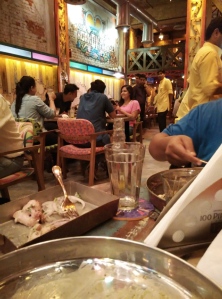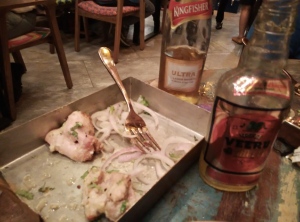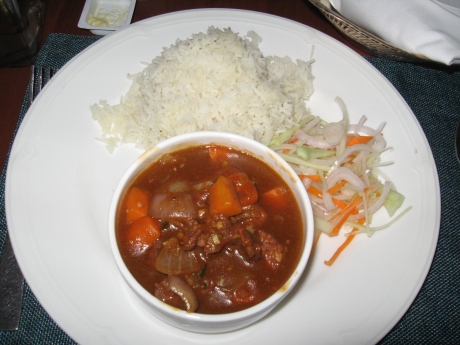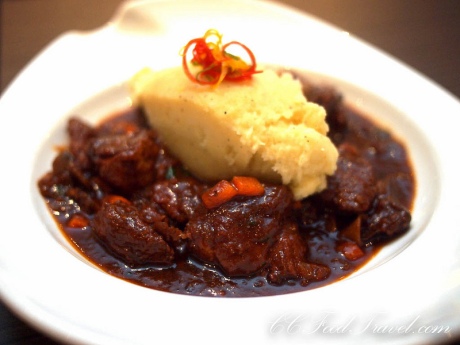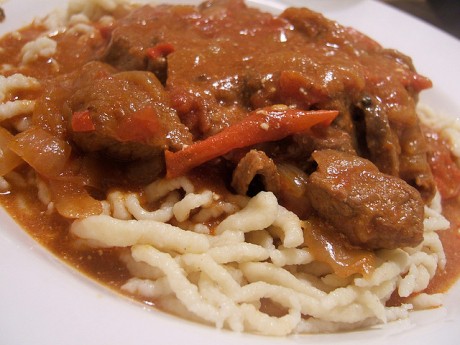Back to kitchen
January 5, 2024
After many many years, i have been cooking on a regular basis for the past two weeks. Partly to keep myself warm in the kitchen in this Dilli ki sardi, and importantly to keep my tummy ticking. So what am i cooking?
Well, basic meals: butter-rice, mashed potatoes and fried eggs; a bowl of boiled veggies — mostly potatoes, padwals, ridge gourds and lady fingers — in a soupy masoor daal (without tadka); a dryish sabzi of diced pumpkin and potatoes and the Bengali brinjal fry to go with frozen parathas. And slightly elaborate ones: fish (basa fillets) and chips with pea mush; chicken daak bungalow (an Anglo-Indian curry with an egg sitting pretty on top); and pan-fried chicken served alongside sauteed broccoli, bell peppers, beans, tomatoes, onions.
Apart from the fact that these dishes are keeping me and the son (occasionally) full, the pottering-around-the-kitchen feel gives me a high. Always. Even at 2am after returning from work. Kitchen is my comfort zone, a pocket of space where i thrive.
As I as write this comeback blog — the last was uploaded on October 6, 2015 — I sadly realise i didn’t take any photo of the dishes i cooked recently. Rather, i didn’t feel the need to. So this blog will have only words. The next time I cook something worth sharing (virtually), I will click a snap or two before tucking in.
Happy cooking. Bon appetit. Ciao
Basanti, yeh restaurant mein mat khana
October 6, 2015
Kingfisher Premium, the cheapest beer on the menu, is unavailable; clueless waiters don’t know the difference between chicken tikka and tandoori; and the dahi ke kabab appears and tastes like parched paneer patties. Welcome to Garam Dharam, Delhi’s newest — and a Dharmendra-themed — eatery in Connaught Place.
It’s a Saturday evening but we surprisingly get a table in an instant. Murals, cutouts and posters of the Jat playboy stare at us from the walls; even the menu card has a story on Dharam paaji: how he made the cut in Bollywood in 1960 after topping Filmfare’s ‘spot the hero’ contest overseen by Messrs Guru Dutt and Bimal Roy.
Like the walls and the rustic rough-hewn décor, complete with a Sholay ki motorbike, the menu card, evidently, has been craftily cooked up: phool aur pathhar ke kebab, Amritsari Pindi Sholay, mere hundum mere gosht (shalgam mutton) mast kalandar handi ke andar (kacche gosht ki biryani) and Dharam veer kesar kheer. Wish, the food received the same innovative treatment.
We call a waiter — his advises us ‘khao piyo mast raho’ — and quiz him on the difference between chicken tikka chaat (Rs 275) and tandoori tikka chaat (Rs 295) and which one would go well with Kingfisher Premium (Rs 80/pint). “Sir, we only have Kingfisher Ultra (Rs 160)”. Huh! The fledgling restaurant has already adopted the time-tested tactic, best perfected by Beer Café, to make your patrons pay more for their drink. And then comes the shocker: “Sir, chicken tikka chaat is tikka and chicken tandoori chaat is tandoori”.
Moved beyond words, we order one of the two — ki farak painda? — and find it an acceptable sliced and diced dry chicken dish topped with chopped tomato and coriander. By the time, the restaurant looks full with 15-20 diners waiting outside. Quite a sight in Delhi, considering many new ventures here draw the same level of attention as Axar Patel in Argentina.
Mutton seekh kebab chaat (Rs 275) — more of nearly the same — tastes like, well, chopped seekhs bought from any roadside thela and hastily garnished with onions, tomatoes, lemon… not a dish you will buy for 275 bucks.
Our disappointment, though, is drowned by laughter ringing from scores of youngsters on a high from Veeru ki ghutti (Rs 150), a mocktail made of sandalwood, cardamom and kaffir lime and served in a bottle — the restaurant’s most popular drink. I have a sip and quickly gulp some beer to retain my sanity. A sandalwood drink? Seriously? Even Veerappan would’nt have, i bet, touched it.
Deciding that we won’t move on to the mains — dinner is ready at home — we order galauti kebab (Rs 395), the litmus test of an Indian chef’s finesse. “Sir, nahin hai,” says our waiter. Then, give us some tawa keema kaleji (Rs 295). “Sorry, sir.” Stopping short of asking “To kya hai”, I ask for, in what I think is a stern tone laced with bitter irony, egg pakoras (Rs 245). Off goes our waiter and comes back in a jiffy. “Sir, pakore to nahi hai, omelette bana du?”
It’s when we, on the edge of our patience, order dahi ke kebab (Rs 295) and murg malai tikka (Rs 295), dishes no one goes wrong with. The chicken’s not bad, but what comes as dahi ke kebab, as I have described earlier, is made of paneer. Dry and solid, no amount of spooning the patty makes it crumble, forget any curd oozing out.
By this time, we are talking work, colleagues, our six-day week; in short, anything but food. The evening has clearly bombed beyond redemption, and as we exit Garam Dharam at 10 at night, we wonder whether dozens of patrons still waiting outside are repeat visitors.
“I would love to give the restaurant my benefit of doubt,” i think aloud, much to my own astonishment. May be it will soon land a new chef who will deliver smash hits like Phool aur Paththar, Anupama, Sholay and Satyakam. After all, wasn’t Mr Dharam Singh Deol’s debut film Dil Bhi Tera Hum Bhi Tere a spectacular flop?
(Garam Dharam, M-16, outer circle, Connaught Place, Delhi)
Maggi is dead, long live Maggi
June 9, 2015
When did i first taste Maggi? I don’t remember but i do know when i ate it the last time.
Maggi defined our childhood, since it hit India in 1982, along with the first colour TV sets, ‘Street Hawk’ bikes, scented erasers, Limca, Rasna, Mile Sur Mera Tumhara, Buniyad… Right, Maggi is sheer nostalgia, the passing of a decade when it permanently transformed our palate so much so that i used to force mom to add a dash of turmeric to Licia, a bland brand of healthy noodle that came without the tastemaker, before i even thought of touching it. Of course, Licia didn’t have Maggi’s curls — some studies say LEAD gives it the twist in the strands — which, ironically, has tied up the Swiss giant into a knot it doesn’t knows how to untangle. But then, who remembers Licia?
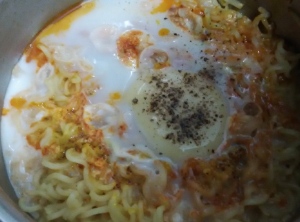 For 33 years, India has slurped Maggi in every form conceivable — outright soupy, hakka and even fried; with peas, carrots, capsicum, onions, tomatoes, chicken shreds and topped with scrambled eggs, bhujia, Kurkure, and whatever one could lay their hands on in haste.
For 33 years, India has slurped Maggi in every form conceivable — outright soupy, hakka and even fried; with peas, carrots, capsicum, onions, tomatoes, chicken shreds and topped with scrambled eggs, bhujia, Kurkure, and whatever one could lay their hands on in haste.
For a perpetually hungry nation, speed is of essence and jugaad, the answer. The result: The fastest of fast food; though Maggi, in reality, takes a couple of minutes more than just two to cook. Other noodle brands tried to replicate its success, but ended up as also-rans. The ‘tastemaker’ was Maggi’s ace: Nestle managed to conjure up the perfect Oriental ‘umami’ flavour.
Once the generation, which grew up lusting after the bright yellow packets lining up the kitchen shelf, left home for studies and jobs far far away, shacks started feeding them what they could have for breakfast, lunch, snack and dinner: an all-weather, all-terrain (thelas on the beach to hasty stoves on Jaisalmer sands to being the perhaps only quick option available in the dizzying Himalayan heights) snack. Maggi made it sure we could live on with a slice of ‘maa’s noodle’ and that we could have a home away from home; in other words, India, for the first time, got a common comfort food — a unifier of sorts, on the lines of cricket.
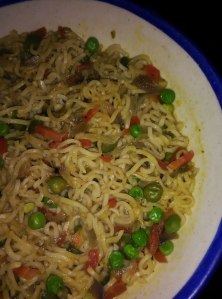 But all along, we knew what we were eating. That the tastemaker is made of MSG, a chemical which most studies have shown as carcinogenic. That the a basic pack of Maggi, even if one discounts the lead overdose, is essentially, unhealthy refined flour. That the apology of vegetables — the microscopic cubes and slices of carrots and tiny shriveled peas that come with the packets, taste rubbery and are anything but fresh and healthy. In short, Maggi’s punchline ‘taste bhi health bhi’ was a sham and the time-bomb was ticking for Nestle.
But all along, we knew what we were eating. That the tastemaker is made of MSG, a chemical which most studies have shown as carcinogenic. That the a basic pack of Maggi, even if one discounts the lead overdose, is essentially, unhealthy refined flour. That the apology of vegetables — the microscopic cubes and slices of carrots and tiny shriveled peas that come with the packets, taste rubbery and are anything but fresh and healthy. In short, Maggi’s punchline ‘taste bhi health bhi’ was a sham and the time-bomb was ticking for Nestle.
When did i last taste Maggi? May the 25th. Even after knowing that the UP Food and Drugs Authority had recalled a particular batch of noodles high on lead and MSG. Hunger struck in the slim hours of morning, the larder was empty, so in went a pack of noodles in boiling water along with just a pinch of tastemaker to give the bubbling mass a straw-yellow color. An egg was gently broken into it and after a liberal sprinkle of mango pickle oil, it was gawkily christened ‘Hakka Maggi in aam aachar ka tel topped with a fried egg’.
All hell has broken loose after that and i have duly fallen back on brown toasts, fruit cocktails and roasted nuts for small eats. Hunger still strikes in the oddest of hours but the corner of the kitchen shelf now brims over with cornflakes, oats and bananas instead of the yellow packets. RIP Maggi. Hope you are reborn in a healthy avatar.
Goulash-e-Hind
January 2, 2013
As they say, if you can’t write a post on the first day of the year, do it on the second. So here goes:
The mercury went on a tailspin from the last week of 2012, and on the 30th, after entertaining guests till the evening, the empty house suddenly felt cold and miserable like a Yorkshire moor. The television did nothing to lift my spirits and i found the kitchen, still swirling with warm flovours of the mutton curry i cooked in the afternoon, inviting.
What now, i asked myself, after switching on the room heater. What would Heathcliff have done were he trapped in a freezing mansion? Pine for Catherine? Nah, a voice told me from within: He would have cranked up the oven and made a pot of Hungarian goulash to keep warm and cheerful!
Now, i did never attempt a goulash before, though i had a nice bowl of it with rice at Taj hotel, Agra. All i could remember was it had a liberal helping of stewed diced carrots and onion rings and that the mutton (they didn’t serve the authentic beef version) was unusually tender.
Determined not to look up the net, i started dicing carrots, onions, tomatoes and garlic pods. There’s a confession for the gastronomic purists: there was no paprika at home, though the mutton chunks were already tender after being marinated in yoghurt for 24 hours.
This, though, was a challenge in itself: the goulash I was to make would take on the flavour of curd; simply put, it could turn into an Indian curry instead of a continental stew. I needed something to neutralize and then overwhelm the curd. What could it be?
The answer lay in the glass in my hand: cabarnet shiraz — Sula’s medium-bodied peppery red wine.
The recipe:
The pan was heated in a jiffy and in went the onion and garlic followed by the tomato. A stir later, i sprinkled a liberal helping of oregano, basil, rosemary, thyme, parsley and pepper to add a Italian twist to was to come. In went the mutton and after five minutes of lightly stir frying it, i poured about six ounces of the wine and an equal quantity of water, just enough to drown the meat. Covering the pan, i let the thing simmer for 45 minutes during which, ahhh, the house started smelling of winey meat and i instantly felt a tad warmer! A couple of chillies slit down the middle and a sprinkling of salt was added and so were another six ounces of wine or so and three cups of water. After an hour of further simmer — yes, you need to be patient because slow cooking takes time — the goulash or whatever you call it, was ready to be had with a baguette.
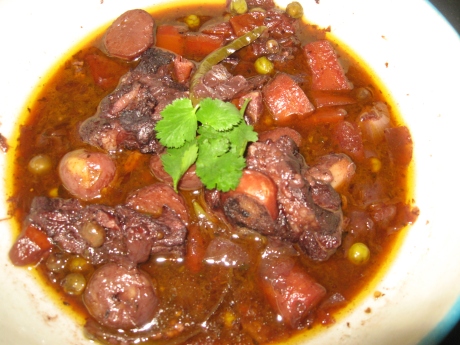
And finally, Goulash-e-Hind, my version of a slice of Hungary in Hindustan! The meat soaked in an enormous amount of wine and turned beet-red. (pic: Dwaipayan Ghosh Dastidar)
The next day, i looked up an authentic recipe of Hungarian goulash, though by then it was too late or “too good”, as a dear friend put it after polishing off a bowl of the stew with some fresh sesame bread.
A glance at the recipe (http://homepage.interaccess.com/~june4/goulash.html) of June Meyer whose mother is from Austria-Hungary, makes it clear how much i deviated, unknowingly so, from the authentic dish. But as they say, all’s well that tastes well!
Taste bhi health bhi
October 19, 2012
So what’s the secret of my energy nowadays? The same as any true-blue Bihari worth his sattu. Yes, ‘chane ka sattu’, the pale liquid that packs a mean punch of energy enough to keep the tummy full till lunch, is my breakfast. Every day. I love it primarily because it’s easy to make: Honey, rock salt and a wedge of lime goes into a jumbo glass, quarter full of the pounded gram. A top-up of cold water and a bit of stirring, and I am ready to take on the world, I mean, household chores.
Though largely associated with Bihari thelawallahs and coolies, my tryst with this protein-packed drink dates back to my childhood, probably because it took me no time to drink a glass of it and dash off to the football field. And when I had a bit more time, I used to be served a thicker version of it in a bowl. The hyper-healthy mash also used to contain unrecognisable remains of banana pulp, a spoon of sugar and a cup of milk. I dare not make the porridge now because over the years, I have turned lactose intolerant and shunned sugar.
Sometimes in the evenings, I have another date with the humble sattu, this time, in the form of litti. Served with piping hot chokha or a mishmash vegetable sabzi, I can polish off a plate or two of the crumbly roasted balls with a spoon of pickle, green chillies and raw onions.
The littiwallah, who seats outside our office just beside the tea stall of Jhaji (by now, you have rightly guessed how my life revolves around Biharis to the extent that a Bhojpuri will say ‘Bangali babu ho gail Bihari’), sometimes goes missing, so devotees such as me have to trudge half-a-kilometre to get hold of his fellow littiwallah.
Just as a write this, an outrageous thought flashes past my mind: What if I spike a thin sattu sorbet with a dash of vodka, add chopped chillies and sprigs of coriander and mint before serving it in a martini glass? Of course, after some shaking and stirring!
** To sample the sattu magic, lunch at Potbelly in Hauz Khas Village, apart from Bihar Bhavan in Lutyen’s Delhi
A homely take on classics
October 18, 2012
I have, as my handful of readers noticed, turned lazy. Shamelessly. The last post I wrote after eight months spanned just 160 words. In short, it ended almost before it began; quite an antithesis to the dinner I had at a friend’s place the other day. My invitation was for — apart from juicy chitchat — fish and chips with beer, an irresistible package for a forced bachelor. It ultimately turned out to be a spread that royalties would be proud to serve.
This was the first time I tasted Kingfisher Ultra, a beer expensive by Indian standards (Rs 85 for a 500 ml can). The playboy brewer has nearly gone bust but it hasn’t had any effect on the beer. It’s light and crispy yet heady, a perfect companion on an autumn evening, and next only to the divine Kings (available only in Goa) and (Danny Denzongpa’s) Dansberg in taste.

The fish and chips I had looked infinitely more tempting than this. I am sure it tasted better as well. (Pic: Gene Hunt/Flickr)
The fish and chips appeared an innovative take on the stuff that you get in restaurants. Humus was served instead of tartar sauce, the fish was not clichéd bekti but meaty basa fillets, firm yet juicy and plump. A bowl of Russian salad completed the package and made me nostalgic. For, I was tasting it probably for the first time since the Nineties, when nearly all caterers in Calcutta used to serve it with cutlets and fries.
The moment I thought that I was full, a stuffed capsicum popped up. Pregnant with minced meat, the vegetable was baked to perfection. By this time, I was going strong on the third can.
The last course was unexpected: one of the finest homemade biryani I ever had and a masterpiece in restraint. Its silky buttery taste, the host explained, came from the marrow of hulking bones clinging on to succulent pieces of mutton and was perfectly complimented by fresh bundi raita.

The homemade biryani was almost as good as this served by Taj hotel, Agra. (Pic: Dwaipayan Ghosh Dastidar)
Though there was no potato and boiled egg accompanying the biryani — sacrilege to a Calcuttan — the juices of the marrow infused into the rice and made us lick our fingers. I will christen the dish nalli biryani, in the fond reminiscence of a former-colleague who used to insist that his biryani — and he used to order a packet of it every evening — must have two nalli pieces.
PS: As if the lavish dinner wasn’t enough, the gracious host drove me home dead at night — a sweet icing on the cake!
PS*: It’s a shame I don’t have pictures of the spread. For, it would have been uncouth to whip out a camera (in any case, I didn’t have one on me) and start clicking like a child.
Twist in the plate
October 15, 2012
What do you do when its lunchtime on Sunday and there’re just a fistful of cooked rice and a couple of frozen fish fillets to fall back on? Simple. Make yourself a G&T and say cheers! Rough-chop a potato, fry it in white oil even as you drizzle it with Tabasco and set aside. Now, thaw the fish and marinate it in salt, pepper, rosemary and olive oil. Heat some more oil in a skillet, fry one side of the fillets brown and turn them over. Coat the brown top in English mustard, taking care so that the sauce doesn’t dribble into the skillet while the lower side gets fried. Turn off the oven after taking the last sip
of your G&T and give the fish a couple of minute’s standing time. In a plate, slide in a knob of butter on the rice, the potato fries and the fish. Switch on the TV and watch Nigella Lawson seductively potter around her kitchen.
An evening in Sevilla
February 5, 2012
I did not write a post for quite some time not only because office had been demanding; i was waiting for the season to fill my plate up with the best of whatever mist-enveloped farms and barns full of fat poultry had to offer.
Winter in Delhi is what the whole year is in Goa — carnival on your platter. The sun dims itself so that you can picnic in Lodhi Gardens, the North wind blows in your face so that you can retreat from the balcony and pour a scotch, the mercury plummets so that the ducks and the koels and the turkeys go easy on your stomach.
The weather had somewhat enlivened last Sunday, so after a lazy day of baking ourselves in the sun and a brisk walk to the fishmonger, we decided to spend the evening sampling the cuisine of the sunny land I long to visit: Espana. It helped that we had a standing invitation from Sevilla, the marquee restaurant in The Claridges, a cozy boutique hotel in the lush and plush Lutyen’s Delhi.
I did a quick bit of homework on Sevilla — the town and the restaurant — and modern Spanish cuisine, though I earlier had the opportunity to polish off a fair amount of tapas and paella rustled up by Spanish journeyman chefs who periodically descend on Delhi.
No amount of study, though, could prepare me for what we were greeted with — a salt tasting session. I dimly remember I had read about it somewhere, but when senior sous chef Rajiv Sinha brought out his prized, literally so, bottles from the larder and laid them on our table, we gasped at the sheer variation in colour and texture of the salts.
From the pink Himalyan (procured from Islamabad after months of coaxing and negotiations with the Pakistani customs) to the blue Iranian and grey Italian to the volcanic black Hawaiian, we licked our way through precious milligrams of exotic and expensive sodium chlorides. Some were strong, some mild, some assaulted the tongues like a whip and the Persian, which I fell for, was faint and smoky — almost like a hazy blue apparition rising from Caspian salt flats in the dusk.
In between, we nibbled on melon slices to cleanse our palates, and I found the odd sip of a medium-bodied Torres white surprisingly appropriate for the occasion.
The session, which Chef Sinha claimed to have innovated and popularised among Claridges patrons, ended with exchanging notes on our favourite salts; the chef loves the Himalayan pink, partly because it’s robust and partly because his father — a geologist who sniffs his way around Himalayan rocks — gifted the pink slab to him on his last birthday.
A long train of tapas, logically, had to come next after we downed a shot of gazpacho with a twist: they made us a warm version of the traditional tomato soup served in a shot glass. My wife liked the poached artichokes and goat cheese salad while I ended up snatching away her foie gras with truffle essence and sea salt. Another round of tapas — smoked prawns and chicken wraps — came and went, leaving us hungering for the main course.
Sucked into the Mediterranean mood by the lush trees forming a canopy, a gurgling brook, quaint cabanas and melodious country music wafting in the background, I changed gears to a full-bodied Torres, though it proved a tad strong for my delicate Caspian Sea black cod that came with smoked watermelon cannelloni, truffled potato dumplings, citrus sabayon and a generous sprinkle of Persian blue salt (Thank you chef for remembering that I loved the salt).
My wife, in the meantime, started dismantling a virtual poetry on her plate — corn-fed chicken beautifully served with charred asparagus and rosemary wedges and garnished with sale grigio di bretagna (Italian grey salt).
By then, it was past 10 at night and we were left as stuffed as fat partridges. But the ever-smiling chef was ready with his dessert. “See, am a Bengali, I have a sweet tooth and you are my guests today,” he smiled coaxingly at us.
So the last half-an-hour went by spooning the apple and pecan crumble paired with granny smith apple jelly, candid orange dust and vanilla bean gelato and revelling in customary conversations that spice up a Bengali-meets-Bengali-outside-Bengal drama.
Now, how was the food? Why have I stopped short of dissecting the dishes? Well, my exposure to Spanish cuisine is not Vir Sanghvi-ish, so I chose to love the evening as it unfolded: a slice of Espana on my plate, interesting conversations with an earnest chef and the warm glow of the cosiness that makes The Claridges a romantic address.
And pop goes the ball!
November 28, 2011
When i was a tiny tot, my ambitions went ding-dong from being a Rajdhani driver to parking my cane basket of golgappas on the roadside. Several decades and reality checks down, i am as content nursing a scotch inside a first class coup of Rajdhani as i am nudging my way through hungry neighbours who ring the golgappa seller near my house. Both — scotch and golgappas — are on top of the pecking order of my food chain; i love the honeydew taste of the yellow liquid and the tang of the minty tamarind water that elevates the potato-stuffed wheat crisps into a divine orbit.
The moment my Rajdhani reaches Bombay, the scotch remains the same, but Delhi’s golgappa becomes panipuri. When the train pulls into Howrah station, the panipuri metamorphoses into fuchka. Next week, i will be in Calcutta for a wedding, but before i dive headlong into the feasting, i will make it a point, as always, to say ‘hi’ to a friendly fuchka-wallah.
I won’t go into the fuchka-is-better-than-golgappa debate because the conclusion is foregone. I would, instead, quietly let you into the Life and Times of a Passionate Fuchka Eater — my wife Sharmi — and let her tell you how a love story in her early life bloomed on the roadsides of Calcutta.
Read on…
I remember a minute incident that happened almost four years back when I came to Delhi the first time after marriage. I’ve always been fond of Delhi. As a teenager whenever we came here on vacation, I loved the greenery, the posh localities and the sprawling roads. But that did not prepare me for living here alone with my husband. I thought I would love it from day one. But surprisingly, Delhi wasn’t that amicable from the word go. It took almost eight months to get adjusted to the Capital.
During those six months, I continuously defended my home, Calcutta. No matter what her flaws were, I used to doggedly stick to saying, “But it has warmth. Delhi lacks the buzz after eight. Calcutta is still alive even at midnight.” Well, it took me some time to realise that Delhi has even more buzz than my little hometown. And warmth? Yes, if you start mingling with the right kind of people.
During one such event of a headstrong defence of my home city, I almost had a nasty altercation with an ex-colleague who tried to malign the reputation of Calcutta’s fuchka. Yes, I’m too much in love with it to like any other type from any other place. When I said, “Calcutta’s fuchkas are the best!” She retorted with a foolish, “Naah! It’s too sour. Delhi’s golgappas are tingly because of the right balance of sweetness and sour.” My ears were burning!
But, I zipped up my lip from hurling out whatever was going on in my head right then because firstly, she was a senior in office, and secondly I thought, what does a Delhi denizen know of the charms of the Calcutta fuchka! “Talk to the hand, you person with no taste,” were the words that kept rotating in my cranial chamber.
I don’t remember the first time I had the heavenly fuchkas of Calcutta. Perhaps, I fell in love with it as a toddler. Who knows? The crunchy hollow wheat breads stuffed with a spicy blob of potato mix and dipped in tamarind water. A wholesome snack that is tingly, aromatic and oh-so- delectable. I can go on and on singing paeans to the Calcutta fuchka.
My brother and I spent much of our childhood on the playground near my paternal grandmother’s house. Ever since I remember, there used to be three vendors sitting outside that playground every single day. One ice-cream seller always ready in his blue uniform, one chholey chaat seller who I remember was extraordinarily amiable and the third one was a lean fuchka vendor. I was never really fond of ice-creams. My brother loved a strawberry version that he demanded almost every day. The chholey chaat seller’s fare was too spicy for us children (Once I grew a bit older I realised that his fare was too good to be missed).
But despite the tender age, I gravitated towards the fuchkas. They looked exciting and tasted heavenly. My granny used to tell me that initially I cried because of the heavy dose of spice, but there was no stopping me from popping them into my mouth. They broke, the water and the potato popped out, but I never gave up. My relationship with fuchkas were forged right then.
While my brother had a fall out with this awesome snack owing to hygiene issues (let’s not even talk about that!), I continue to be faithful to it.
The great thing about Calcutta’s fuchkas is that they are available in every nook and cranny of the city. There are those poor vendors with their grimy clothes and tiny boxes and vessels, and there are those well-to-do ones with their gigantic fuchkas that are difficult to have at a go. There is one notable thing however. Fuchkas vendors never sell their snack in the day. Come evening, they all carry their mobile stalls at their designated spaces and station there till late into the night. When they go back home, their boxes are empty, the potatoes all gobbled and the tamarind water drunk by faithful clients like me.
I loved my shopping trips with my mum. And after a hectic but pleasurable retail therapy, the day would invariably end with fuchkas in Gariahat. Then there were those times when I would sneak out of the house with a bit of money to gobble fuchkas from the vendor who sat near my house. Right there near the bus stop, his tiny bulb shed light on his spicy ware as he dished out a delicious mix. There are stories like this galore…
The vendor near my childhood playground was not a very well-to do man. I do not see him anymore. Perhaps he is too old to carry on with his trade, or maybe he could not sustain this job due to hardships. There is a younger fellow who sells fuchkas from that spot now. I’ve tasted his snack once. They are not half as good…
While in college, my best friend and I ate fuchkas everyday! Now, they might taste blissful, but all that spice and tamarind can be a bit nasty to the tummy. But with young blood in our veins, we threw caution to the air. While my friend sometimes hesitated, I made it a ritual to go to Camac Street from Loreto College to have my fill during lunch recess. My mother still does not know that! She thinks my college lunches comprised of the tame chapati and vegetables that she packed for me in the morning. And, I’m not going to tell her that I forced that tiffin down my classmates’ throats so that I could feast on fuchkas.
The fuchkas sold at Camac Street, Russel Street and Lake was a tad different from what I grew up on. I firmly believed that fuchkas would be incomplete without tamarind water (a natural purgative). But here, the vendors substituted tamarind water with mint water (pudina). Anyways, this wasn’t bad either. In Delhi too, the water is made of crushed mint leaves, green chillies and spices.
When we had gone to Andamans, I was thrilled to bits discovering a lone fuchka seller near Cellular Jail. I implored my mum to buy me a plate. But it was so disappointing. The vendor filled the fuchkas with ghooghni before serving them. Preposterous!!
In Delhi too, fuchkas disappoint me. Not that I don’t have them. It’s after all much better to have a bad copy than not having it at all. True for fuchkas, at least. But here, they cut the boiled potatoes into cubes, rub some black salt on them, fill the fuchkas with them and serve them with mint water. Nothing like the tamarind infused, super spicy potato of the Calcutta fuchka, mashed immaculately with love…
King Con
November 19, 2011
Succulent whole chillies, delicately cooked in a thick gravy of roasted peanuts, almonds and sesame seeds. A gourmet, ready to eat dish created by the Master Chefs of ITC Hotels.
Thus reads the description of the iconic Mirch ka Salan, packed in an equally iconic yellow packet, both screaming of the fame of Kitchens of India’s Dum Pukht style of cooking.
I started salivating the moment the ready-to-eat delicacy fell into my hands, thanks to a colleague and star food critic.
My wife, though, sounded circumspect. She recalled that a decade ago she had coaxed her father into buying a similar ITC packet of palak paneer and how she was reduced to tears on seeing just two or three paneer cubes trying to hide in a mesh of palak in the pan. Taste? She vouches she has had far better stuff at the landmark Balwant Singh Dhaba in Kolkata’s Bhawanipur.
Well, cynics will always be cynics, I felt when i heated the saucepan the other night, ready to empty the contents. Out came the salan (literally, ‘gravy’) and the moment I saw it, my heart sank. It looked a pale version of what all of us have had in restaurants. It looked a shadow of a shadow of the picture in the packet. No whiff of anything, forget that Hyderabadi aroma, filled up the kitchen when the gravy started bubbling a minute later.
The salan, a canned paste with limp chillies buried in it, tasted like NOTHING. If there were any peanuts, almonds, curry leaves and sesame seeds, the palate could not understand. A sharp sourness spoiled the paranthas, spoiled our meal and I felt I was having an unmitigated sludge of earth that floods wash down.
Dinner done, I asked myself: Would ITC serve this salan in its restaurants? If not, why on earth should it fool us to buy the trash from the shelves for almost a hundred bucks? Is it a case of packaging gone wrong or a case of conveyer-style cooking just for the unsuspecting common man who can’t visit a Bukhara or a Dum Pukht and will nod merrily while eating any packed stuff that Brand ITC offers? Had it been the Western world, people would surely have sued the hospitality giant for the contents in the packet not matching the picture on the packet.
I felt humiliated and cheated, though i thankfully didn’t have to spend a buck for the crap. I would request the head of the ITC food division, sitting pretty in Bangalore, to try tasting what he sells. If his wife doesn’t turn him out of the house after a spoon of this Mirch ka Salan, I will shut down this blog and never talk or write about food. It’s a promise.
PS: In case if you feel Mirch ka Salanish, try this Sanjeev Kapoor recipe. Please write back and tell us how it went.
How to do it
Wash, wipe and slit green chillies lengthwise without cutting the chillies into two.
Heat sufficient olive oil in a kadai (wok) and deep-fry for one minute. Drain and place on absorbent paper and set aside.
To make masala paste, dry roast sesame seeds, coriander seeds and cumin seeds. Cool and grind them to a paste along with peanuts, whole dry red chillies, ginger and garlic.
Heat two tablespoons oil in a pan, add mustard seeds, let them splutter and add curry leaves. Sauté for half a minute and add onion. Sauté, stirring continuously, till onion is light golden brown.
Add turmeric powder and mix well. Add masala paste and cook for three minutes, stirring constantly. Stir in one and half cups of water and bring it to a boil. Reduce the heat and cook for ten minutes.
Add tamarind pulp (dissolved in half a cup of water, if it is too thick). Add fried green chillies and salt and cook on low heat for eight to ten minutes. Serve hot.

